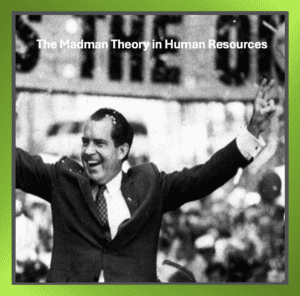The Madman Theory in Human Resources
In the changing business environment, the intersection of Human Resources (HR) and creative leadership approaches, such as the Madman Theory, offers valuable insights into promoting innovation, employee engagement, and organisational success.

Applying the Madman Theory to HR encourages creativity and unconventional strategies for organisational growth
Understanding the Madman Theory
The Madman Theory, originated by former U.S. President Richard Nixon, posits that a leader can display unpredictability and unconventional behaviour to intimidate opponents and gain leverage. In a business context, this theory emphasises the importance of creative thinking over traditional approaches to leadership and problem-solving. While it may seem chaotic at first glance, the underlying principle is about challenging norms and embracing bold strategies to achieve significant outcomes.
Embracing Unconventional Thinking in HR
- HR plays a crucial role in nurturing an organisational culture that encourages innovative thought processes. Here’s how elements of the Madman Theory can be integrated into HR practices:
- Encouraging Creativity: HR can create a work environment that celebrates unconventional ideas. By promoting a culture where employees feel free to voice eccentric suggestions without the fear of ridicule, organisations can tap into a wealth of innovative solutions.
- Flexibility in Policies: HR can adopt flexible policies that allow for unique work arrangements. This adaptability mirrors the unpredictability associated with the Madman Theory, giving employees the freedom to explore new ways of working.
- Diverse Talent Pool: Hiring individuals from diverse backgrounds brings varied perspectives. Embracing different ideas aligns with the Madman Theory’s focus on breaking out of traditional moulds, leading to richer brainstorming sessions and creative problem-solving.
- Risk-Taking and Learning: HR can endorse calculated risks and view failures as learning opportunities. By encouraging employees to step out of their comfort zones, organisations can cultivate a more resilient and innovative workforce.
The Balance: Structure and Freedom
While the Madman Theory promotes creative freedom, a successful HR strategy should also maintain a balance between structure and chaos. Here’s how HR can manage this equilibrium:
- Guidelines for Innovation: Establish parameters within which creativity can flourish. This keeps teams aligned with organisational goals while allowing flexibility to explore new ideas.
- Feedback Mechanisms: Implement channels for providing constructive feedback. This ensures that while employees can think outside the box, their ideas are still refined and relevant to the company’s objectives.
- Celebrating Successes: Recognise and reward innovative ideas that lead to successful outcomes. Celebrating these achievements reinforces the value of creativity within the organisation.
Integrating the principles of the Madman Theory into HR practices can help organisations support an environment rich in creativity and innovation. As businesses face unprecedented challenges and competition, embracing unconventional thinking paired with strategic HR practices can propel them toward sustained success.
By promoting a culture where creativity is celebrated, diversity is embraced, and calculated risks are encouraged, HR can transform the workforce into a powerhouse of innovative thinkers.
After all, in a world that often values conformity, it’s the “mad” ideas that may very well lead to groundbreaking advancements.
